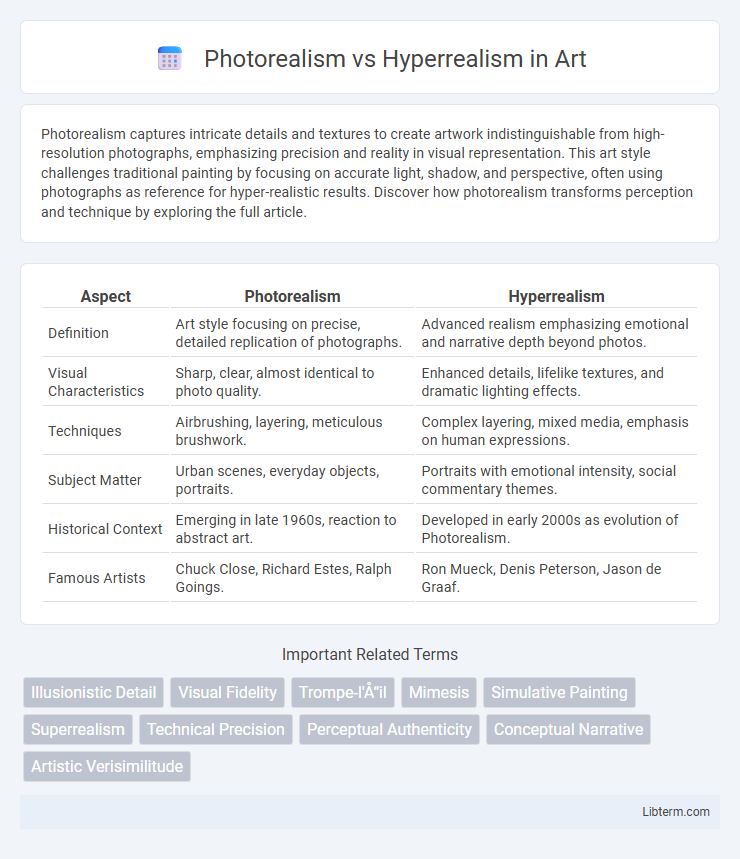Photorealism captures intricate details and textures to create artwork indistinguishable from high-resolution photographs, emphasizing precision and reality in visual representation. This art style challenges traditional painting by focusing on accurate light, shadow, and perspective, often using photographs as reference for hyper-realistic results. Discover how photorealism transforms perception and technique by exploring the full article.
Table of Comparison
| Aspect | Photorealism | Hyperrealism |
|---|---|---|
| Definition | Art style focusing on precise, detailed replication of photographs. | Advanced realism emphasizing emotional and narrative depth beyond photos. |
| Visual Characteristics | Sharp, clear, almost identical to photo quality. | Enhanced details, lifelike textures, and dramatic lighting effects. |
| Techniques | Airbrushing, layering, meticulous brushwork. | Complex layering, mixed media, emphasis on human expressions. |
| Subject Matter | Urban scenes, everyday objects, portraits. | Portraits with emotional intensity, social commentary themes. |
| Historical Context | Emerging in late 1960s, reaction to abstract art. | Developed in early 2000s as evolution of Photorealism. |
| Famous Artists | Chuck Close, Richard Estes, Ralph Goings. | Ron Mueck, Denis Peterson, Jason de Graaf. |
Defining Photorealism: Origins and Key Features
Photorealism emerged in the late 1960s as an art movement aiming to replicate photographs with meticulous precision, emphasizing detail, lighting, and surface texture to create lifelike images. Originating as a reaction to abstract expressionism, it involves artists using photographs as references to produce paintings that closely mimic the clarity and focus of a camera's lens. Key features include sharp contours, accurate reflections, and an emphasis on everyday scenes, capturing reality with scientific accuracy but often without exaggeration.
Hyperrealism Explained: Beyond Photographic Precision
Hyperrealism transcends photorealism by emphasizing meticulous detail and enhanced emotional impact, creating artworks that not only replicate but intensify reality. This art movement incorporates subtle textures, light effects, and context that evoke a lifelike presence beyond mere photographic accuracy. Hyperrealistic artists often use advanced techniques and mediums to produce images that challenge viewers' perceptions, making their work appear even more vivid and tangible than high-resolution photographs.
Historical Context: Emergence of Photorealism and Hyperrealism
Photorealism originated in the late 1960s as a response to Abstract Expressionism, with artists like Chuck Close and Richard Estes emphasizing precise, photographic detail achieved through meticulous observation and technique. Hyperrealism emerged in the early 2000s, evolving from Photorealism by incorporating emotional narratives and enhanced detail to create an illusion of reality that often surpasses photographic quality. Both movements reflect technological advancements in photography and a growing cultural fascination with realism and visual perception during their respective periods.
Pioneers and Influential Artists in Each Movement
Photorealism emerged in the late 1960s with pioneers like Chuck Close and Richard Estes, whose meticulous attention to photographic detail redefined contemporary realism. Hyperrealism, evolving from Photorealism in the early 2000s, features artists such as Ron Mueck and Roberto Bernardi, who emphasize emotional depth and three-dimensional precision beyond photographic accuracy. Both movements share a commitment to extraordinary detail but differ in their interpretive ambitions and expressive techniques.
Artistic Techniques: Tools, Materials, and Processes
Photorealism employs traditional tools such as graphite pencils, acrylic paints, and airbrushes to replicate photographic images with meticulous attention to detail, emphasizing smooth gradients and precise shading. Hyperrealism utilizes advanced materials like oil paints and digital aids, integrating layering techniques and textural details to produce artwork that often transcends photographic clarity, capturing emotions and narrative depth. Both styles demand rigorous processes, but Hyperrealism incorporates sculptural effects and enhanced light reflections to evoke a lifelike presence beyond mere replication.
Subject Matter: Differences in Themes and Motifs
Photorealism emphasizes everyday scenes and objects, capturing the mundane with meticulous detail to reflect contemporary life and urban landscapes. Hyperrealism, however, intensifies emotional depth and narrative by incorporating imaginative or surreal elements, often focusing on human expressions and intricate textures that evoke psychological responses. While Photorealism prioritizes photographic accuracy, Hyperrealism explores themes of perception, identity, and existence through amplified realism and storytelling.
Emotional Intent: Interpretation versus Documentation
Photorealism emphasizes meticulous replication of photographic details to document reality with precision, often prioritizing technical skill and exact visual accuracy. Hyperrealism, while equally detailed, infuses emotional depth and narrative layers, aiming to evoke stronger emotional responses through interpretive enhancements beyond the photograph. The distinction lies in Photorealism's focus on objective representation versus Hyperrealism's engagement with subjective emotion and story.
Comparing Visual Impact: Viewer Engagement and Experience
Photorealism emphasizes meticulous replication of photographic detail, fostering viewer engagement through recognition and clarity, while Hyperrealism amplifies reality by adding emotional depth and narrative layers, creating a more immersive and provocative experience. Photorealism's visual impact often relies on precision and surface accuracy, attracting viewers through technical skill and familiar imagery. In contrast, Hyperrealism enhances textures, light, and context to evoke stronger emotional responses and encourage deeper contemplation of the subject matter.
Photorealism vs Hyperrealism in Contemporary Art
Photorealism in contemporary art emphasizes meticulous replication of photographic images, capturing minute details and lighting to create lifelike scenes. Hyperrealism advances this approach by incorporating emotional narratives and depth, often enhancing textures and expressions to evoke a more intense, immersive experience. Both movements challenge perceptions of reality but differ in intent--Photorealism as precise visual documentation, Hyperrealism as an amplified, often surreal interpretation of everyday life.
Collecting, Exhibiting, and Market Trends
Photorealism and Hyperrealism both command strong interest in contemporary art collecting, with Photorealism appreciated for its precise depiction of everyday scenes and Hyperrealism gaining traction for its intense detail and emotional depth. Galleries and museums increasingly exhibit these styles side by side, noting rising attendance and engagement due to their visual impact and narrative complexity. Market trends reveal growing auction prices and collector demand, particularly for emerging Hyperrealist artists, while established Photorealists maintain stable valuation, highlighting a dynamic interplay between technical mastery and evolving artistic expression.
Photorealism Infographic

 libterm.com
libterm.com